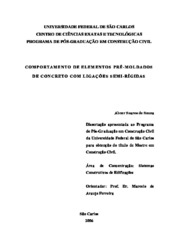| dc.contributor.author | Souza, Abner Soares de | |
| dc.date.accessioned | 2016-06-02T20:09:04Z | |
| dc.date.available | 2007-05-15 | |
| dc.date.available | 2016-06-02T20:09:04Z | |
| dc.date.issued | 2006-09-01 | |
| dc.identifier.citation | SOUZA, Abner Soares de. Behaviour of concrete precast elements with semi-rigid connections.. 2006. 118 f. Dissertação (Mestrado em Ciências Exatas e da Terra) - Universidade Federal de São Carlos, São Carlos, 2006. | por |
| dc.identifier.uri | https://repositorio.ufscar.br/handle/ufscar/4606 | |
| dc.description.abstract | The behaviour of reinforced concrete precast beams is strongly influenced by the flexural
stiffness of its beam-column connections, wherein there is interdependence between the nonlinearity
of the moment-curvature relationship along the beam and the non-linearity of the
moment-rotation relationship of the beam-column connections. In most of the existing
researches on semi-rigid connections in precast structures, the main focus lays on the
characterization of the flexural stiffness by performing experimental tests on isolated models
of beam-column connections instead of tests on sub-frames, comprising beam and
connections. In this research an experimental procedure was developed, wherein different
theoretical equations based on the fixity factor of the connections were combined, allowing
the integration between the stiffness of the reinforced concrete beam with the flexural
stiffness of the beam-column connections. Therefore, by using this procedure it was possible
to evaluate the semi-rigid behaviour of the beam-column connection, highlighting the
possibility of carrying out just one test for the precast beam with its connections. The analyses
of the experimental results indicate that the studied connection was capable of absorbing
around 53% of the elastic beam-end moment at the ULS, compared with the situation of a full
restrained connector, implying the increase of 170% of the positive mid-span moment of the
beam. This level of semi-rigid behaviour for the beam-column connection can affect the
global stability of skeletal precast concrete structures with more than five storeys in height.
For this reason, the present research shows the need for further studies with the purpose of
enhancing the analysis and the design of precast concrete structures for multi-storey buildings. | eng |
| dc.description.sponsorship | Universidade Federal de Minas Gerais | |
| dc.format | application/pdf | por |
| dc.language | por | por |
| dc.publisher | Universidade Federal de São Carlos | por |
| dc.rights | Acesso Aberto | por |
| dc.subject | Concreto pré-moldado | por |
| dc.subject | Ligações semi-rígidas | por |
| dc.subject | Ligações viga-pilar | por |
| dc.subject | Rigidez à flexão | por |
| dc.subject | Beam-column connections | eng |
| dc.subject | Semi-rigid connections | eng |
| dc.subject | Precast beams | eng |
| dc.subject | Flexural stiffness | eng |
| dc.title | Comportamento de elementos pré-moldados de concreto com ligações semi-rígidas | por |
| dc.title.alternative | Behaviour of concrete precast elements with semi-rigid connections | eng |
| dc.type | Dissertação | por |
| dc.contributor.advisor1 | Ferreira, Marcelo de Araújo | |
| dc.contributor.advisor1Lattes | http://lattes.cnpq.br/4199122391532470 | por |
| dc.description.resumo | O comportamento das vigas pré-moldadas de concreto armado é fortemente influenciado pela
rigidez à flexão das ligações viga-pilar, existe uma interdependência entre a não linearidade
da relação momento-curvatura ao longo da viga pré-moldada com a não linearidade da relação
momento-rotação nas ligações viga-pilar. A maioria das investigações experimentais
existentes sobre ligações semi-rígidas em estruturas pré-moldadas, tanto na literatura nacional
quanto internacional, têm enfatizado seus estudos na caracterização da rigidez à flexão de
maneira isolada, não realizando ensaios do comportamento conjunto das vigas pré-moldadas
com as suas ligações. Desenvolve-se nesta pesquisa um procedimento experimental onde se
procurou integrar diversos equacionamentos teóricos com base no fator de restrição aos giros
na ligação, os quais permitiram integrar parâmetros de rigidez da ligação e da viga. Desta
forma, com base nos resultados experimentais em um único ensaio de um modelo de viga
com ligações viga-pilar, foi possível se estimar o engastamento parcial nas ligações viga-pilar.
A partir dos resultados experimentais, a ligação viga-pilar foi capaz de absorver cerca de 53%
dos momentos elásticos na extremidade da viga, havendo assim um acréscimo de 170% no
momento positivo no centro da viga para a situação de projeto no ELU. Este engastamento
parcial pode afetar sensivelmente a estabilidade global de estruturas pré-moldadas com mais
de 5 pavimentos. Por esta razão, o presente estudo aponta para a necessidade de mais
pesquisas nesta área, com o objetivo de possibilitar projetos mais adequados e seguros de
estruturas pré-moldadas em esqueleto para múltiplos pavimentos. | por |
| dc.publisher.country | BR | por |
| dc.publisher.initials | UFSCar | por |
| dc.publisher.program | Programa de Pós-Graduação em Engenharia Civil - PPGECiv | por |
| dc.subject.cnpq | ENGENHARIAS::ENGENHARIA CIVIL::CONSTRUCAO CIVIL | por |
| dc.contributor.authorlattes | http://buscatextual.cnpq.br/buscatextual/visualizacv.do?id=T272550 | por |
